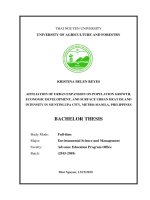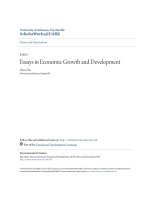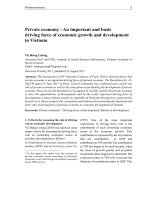Economic growth and economic development 702
Bạn đang xem bản rút gọn của tài liệu. Xem và tải ngay bản đầy đủ của tài liệu tại đây (123.38 KB, 1 trang )
Introduction to Modern Economic Growth
Proposition 15.11. Consider the directed technological change model with no
scale effects described above. If
σ > 2 − λ,
then there is strong equilibrium (relative) bias in the sense that an increase in H/L
raises the relative marginal product and the relative wage of the H factor compared
to the L factor.
15.6. Endogenous Labor-Augmenting Technological Change
One of the advantages of the models of directed technical change is that they
allow us to investigate why technological change might be purely labor-augmenting
as required for balanced growth. We will see that models of directed technological
change create a natural reason for technology to be more labor augmenting than
capital augmenting. However, under most circumstances, the resulting equilibrium
is not purely labor augmenting and as a result, a BGP fails to exist. However, in
one important special case, the model delivers long-run purely labor augmenting
technological changes exactly as in the neoclassical growth model, thus providing a
rationale for one of the strong assumptions of the standard growth models.
In thinking about labor-augmenting technological change, it is useful to consider
a two-factor model with H corresponding to capital, i.e., H (t) = K (t). Given the
focus on capital, throughout the section we use NL and NK to denote the varieties
of machines in the two sectors. Let us also simplify the discussion by assuming
that there is no depreciation of capital. Note also that in this case the price of the
second factor, K (t), is the same as the interest rate, r (t), since investing in the
capital stock of the economy is a way of transferring consumption from one instant
to another.
Let us first note that in the context of capital-labor substitution, the empirical
evidence suggests that an elasticity of substitution of σ < 1 is much more plausible
(whereas in the case of substitution between skilled and unskilled labor, the evidence
suggested that σ > 1). An elasticity less than 1 is not only consistent with the it
available empirical evidence, but it is also economically plausible. An elasticity of
688









